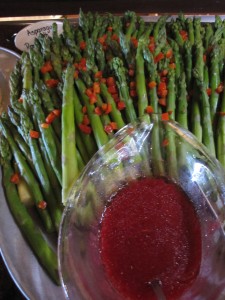Be sassy with fiber
 Fiber is everywhere – on your nutrition labels, on television ads, in the brochures at your physician’s office. What is fiber? It’s an indigestible substance that is found mainly in the outer layers of plants. The best of it is that our locally grown produce – both vegetables and fruits – are high in fiber!
Fiber is everywhere – on your nutrition labels, on television ads, in the brochures at your physician’s office. What is fiber? It’s an indigestible substance that is found mainly in the outer layers of plants. The best of it is that our locally grown produce – both vegetables and fruits – are high in fiber!
As it’s a special type of carbohydrate that passes through our digestive system unchanged, we don’t have to worry about calories due to fiber intake! It’s broken down in the colon – the main part of the large intestine – by bacteria and the organic acids produced help nourish the lining of the colon.
You might have heard about two types of fiber – one known as soluble fiber and the other, insoluble fiber.
Soluble fiber forms a gel when mixed with liquid (water) and it can be found mostly in beans, oat bran, flax seed, cereals and fruits.
Insoluble fiber passes through our intestine intact. Foods such as wheat bran, whole grain cereals and vegetables (green beans, dark green leafy vegetables), seeds and nuts, fruit skins and root vegetable skins, tend to be low in fat and high in fiber.
Our locally grown dark greens are packed with fiber! I enjoy “mixing and matching” these vegetables in a hot or a cold dish. If I want something hot, then I’ll grate the rainbow carrots and beets, toss together with coarsely chopped arugula and spinach leaves, maybe add some sliced tomatoes. Calories add up with our traditional dressings so you might want to try just vinegar, lemon juice and some spices for a no-calorie treat.
Benefits of Fiber:
- Promotes regular bowel movement and prevents constipation
- Removes toxic waste through the colon quicker
- Maintains a healthy intestine
- Decreases cholesterol levels by lowering LDL or “bad cholesterol” protecting our heart
- Maintains sugar levels stable by decreasing the absorption of sugars – a plus for diabetics
- Helps us lose weight – high fiber foods fill us up so we’re not hungry as often
The national recommendations for adults include approximately 25 grams per day. It’s not easy to consume that much fiber on a daily basis so start to read labels, eat more fresh produce (5-9 small servings) or a combination of beans, whole grain cereals, fruits and vegetables for overall health.
By dividing your fiber requirements throughout small, frequent meals, you can add variety, color and more opportunities to include both insoluble and soluble fiber to your meals!
